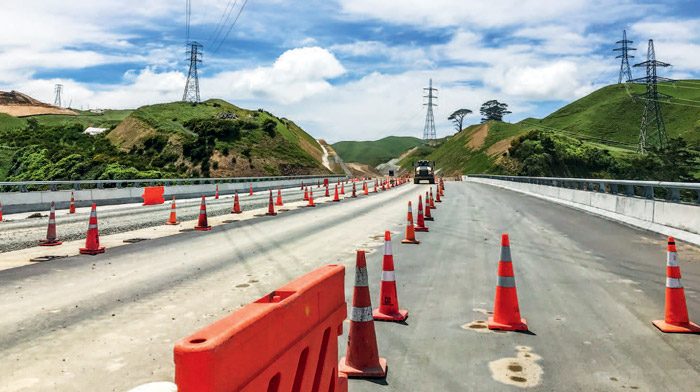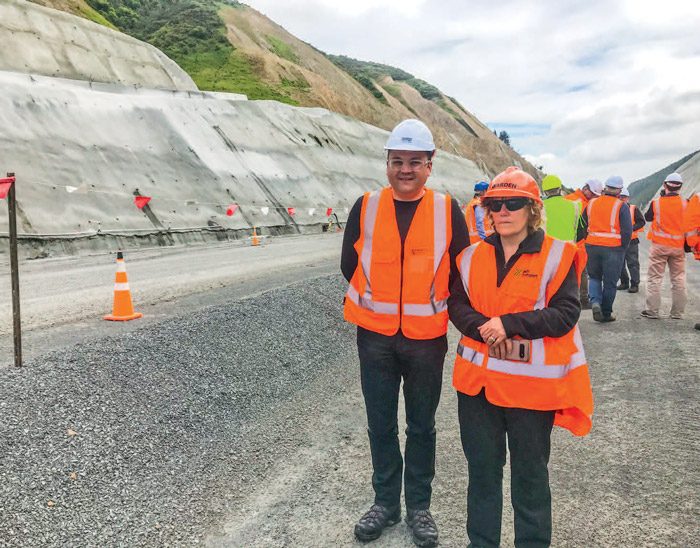Progress on new roads but plenty more to do
I recently toured the new Transmission Gully motorway project with RTF board member and local freight operator Deborah O‘Brien. As New Zealand Trucking readers will know, the project hasn‘t been without its problems, and I have been pretty critical of the time it has taken to complete. However, driving it gave me an appreciation of its immense scope and the significant engineering challenges that have been overcome. More than 10,000,000m³ of earth has been moved, and there‘s a pretty impressive incline to the 253m Wainui Saddle. The project also includes 27km of stream remediation and planting 2.5 million native trees and plants. I was impressed with some of the road‘s safety features, including a 250m-long ‘arrestor bed‘ on the long northbound descent from the Wainui Saddle. This is a gravel-filled ramp adjacent to the road that can be used to stop a runaway vehicle. It has been designed to bring heavy vehicles to a halt in an emergency, such as a brake or gearbox failure. Lower North Island freight operators are equally excited about the Te Ahu a Turanga: Manawatu Tararua Highway project that is finally taking shape, with the prime minister turning the first sod before Christmas.
The new route, situated just north of the old Manawatu Gorge route that was permanently closed after the massive slip in April 2017, will be 11.5km long with two lanes each way. It will have a drive time of about 13 minutes for light vehicles and 18 minutes for freight and provide a high-quality link over the Ruahines between Ashurst and Woodville. Te Ahu a Turanga: Manawatu Tararua Highway will be a critical freight connection between the eastern and western sides of the lower North Island and is due for completion in 2024. RTF will keep a close eye on progress. While things are looking up for road users in the lower North Island, there are still some serious roading and congestion issues to sort out in central Wellington, which unfortunately is still locked in a political deadlock. Auckland, on the other hand, is a primary focus for government transport planners. Although a considerable amount of money has been invested in transport in the city, several important roading initiatives that would alleviate congestion for the road transport industry, including the East- West Link, have not seen much progress at all. While improving metro rail services is important and will certainly improve commuter mobility in and around the central city, a significant deficit remains in roading infrastructure.
This continues to make life difficult for upper North Island road transport operators and is a considerable drag on the New Zealand economy. To illustrate the size of the task ahead in Auckland, a recent report by the NZTA has estimated that by 2046, 27,000 trucks will need to cross Auckland Harbour every day. The report, which looks at a second harbour crossing, has estimated that to develop the future infrastructure required for that project alone will cost somewhere between $6 billion and $18 billion, depending on the project‘s scale, and would primarily have to be paid for by the central government. It‘s eye-watering stuff. Sticking with road building, I was astonished to read over the Christmas period that Refining New Zealand is to stop bitumen production at its Marsden Point refinery at the end of January 2021. The decision seems at odds with the record amount of money currently being spent on transport infrastructure, including road building and maintenance. But according to reports, there is now an oversupply of bitumen in the Asia Pacific region, so it just wasn‘t economical anymore. Still, with some of the challenges we have seen this year with the international supply chain, it does make me nervous that we will now rely 100% on imported bitumen for our roading. The NZTA assures us that relying on imports will not impact future projects, and already work is underway to ensure the quality of the bitumen we import and to develop additional storage capacity. Here‘s hoping the organisation is right.

Photo: The new route has presented some significant engineering challenges.

Photo: Nick Leggett and RTF board member Deborah O‘Brien inspect progress on Transmission Gully.
Read more
Best of 2021
0 Comments10 Minutes
The Go On Auslowe
0 Comments14 Minutes




